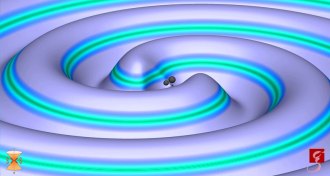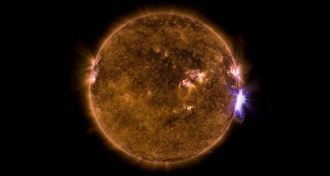Physics
Sign up for our newsletter
We summarize the week's scientific breakthroughs every Thursday.
-
 Physics
PhysicsTrio of detectors tracks gravitational waves to their home
LIGO and Virgo spot spacetime ripples in their first joint detection.
-
 Physics
PhysicsTurning up the heat on electrons reveals an elusive physics phenomenon
Heating a strip of platinum creates a “spin current” in the material’s electrons due to the spin Nernst effect.
-
 Astronomy
AstronomyUltrahigh energy cosmic rays come from outside the Milky Way
The biggest cosmic ray haul ever points toward other galaxies as the source of the rays, not our own.
-
 Quantum Physics
Quantum PhysicsA new test of water ripples supports the idea of quantum heat in a vacuum
Water waves bolster theory that accelerating space travelers really feel the heat.
-
 Materials Science
Materials ScienceTiny ‘supraballs’ put a new spin on creating long-lasting color
Nano-sized balls of melanin and silica generate durable colors.
-
 Animals
AnimalsAnimal goo inspires better glue
Researchers are turning to nature to create adhesives that work in the wet environment of the human body.
-
 Physics
PhysicsHow to peel permanent marker off glass
Water’s surface tension can peel a thin hydrophobic film such as permanent ink off glass surfaces.
-
 Astronomy
AstronomyThe sun’s strongest flare in 11 years might help explain a solar paradox
The sun tends to release its biggest flares at the ends of solar cycles — and we might finally be able to test why.
-
 Particle Physics
Particle PhysicsDark matter still remains elusive
Scientists continue the search for particles that make up the universe’s missing matter.
-
 Particle Physics
Particle PhysicsThe results from a slew of experiments are in: Dark matter remains elusive
Scientists continue the search for particles that make up the universe’s missing matter.
-
 Quantum Physics
Quantum PhysicsMinuscule jitters may hint at quantum collapse mechanism
Vibrations of a tiny cantilever could help reveal why quantum rules fail on large scales.
-
 Tech
TechTiny quantum storage device fits on a chip
Photon information processing on nanoscale could enable future communication networks.